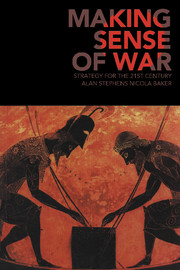Book contents
- Frontmatter
- Contents
- Abbreviations
- Preface
- Introduction
- Chapter 1 How to win
- Chapter 2 Stove-piped strategy
- Chapter 3 Traditional warfighting concepts and practices
- Chapter 4 Manoeuvre and the application of force
- Chapter 5 Shaping the strategic environment
- Chapter 6 Strategic paralysis
- Chapter 7 Contemplating war
- Chapter 8 Constraints on war
- Chapter 9 Controlling war
- Chapter 10 Peacemaking
- Chapter 11 War in the twenty-first century
- Notes
- Select bibliography
- Index
Chapter 5 - Shaping the strategic environment
Making strategy work
Published online by Cambridge University Press: 05 June 2012
- Frontmatter
- Contents
- Abbreviations
- Preface
- Introduction
- Chapter 1 How to win
- Chapter 2 Stove-piped strategy
- Chapter 3 Traditional warfighting concepts and practices
- Chapter 4 Manoeuvre and the application of force
- Chapter 5 Shaping the strategic environment
- Chapter 6 Strategic paralysis
- Chapter 7 Contemplating war
- Chapter 8 Constraints on war
- Chapter 9 Controlling war
- Chapter 10 Peacemaking
- Chapter 11 War in the twenty-first century
- Notes
- Select bibliography
- Index
Summary
ANY RESORT TO ARMED conflict is likely to indicate a policy failure of some kind, since ideally our grand strategic activities should enable us to achieve our goals without resort to force. As is always the case there will be exceptions, for instance, when one protagonist is determined to use organised violence as his method of first choice, regardless of anything else. Examples include Hitler's policies to exterminate the Jewish race and subjugate Slavic nations as slaves, and the ethnic cleansing pursued through open warfare in the Balkans in the 1990s. But generally, interest groups prefer to achieve their policy goals by shaping the strategic environment: by influencing attitudes and events in favour of their objectives.
SHAPE-DETER-RESPOND
The idea of trying to make strategy work for us reflects the classic strategic hierarchy of ‘shape-deter-respond’, under which the order of priorities is: first, influence the environment in which we function – political, diplomatic, economic, social, cultural, military, geographic – towards our interests; second, if shaping is not entirely successful, deter behaviour that might be inimical to those interests; and last, if deterrence fails, respond as necessary anywhere along the spectrum of influence from, say, soft sanctions at one extreme to war at the other. Shaping strategies will be directed towards our own strengths and preferences, and typically will involve diplomacy, alliances, trade and economic agreements, military exercises, and cultural exchanges.
- Type
- Chapter
- Information
- Making Sense of WarStrategy for the 21st Century, pp. 101 - 133Publisher: Cambridge University PressPrint publication year: 2006

